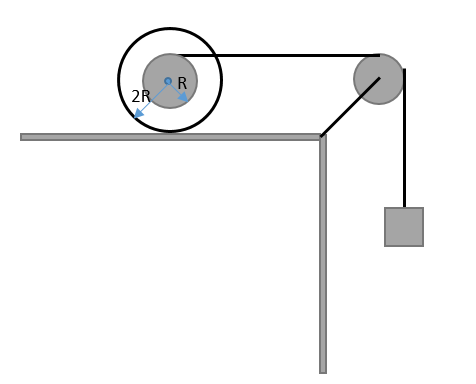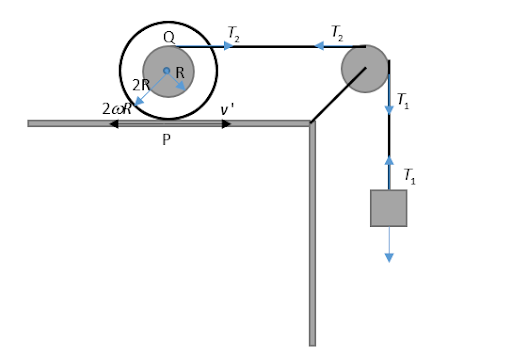
In the figure shown mass of both, the spherical and block is m. The moment of inertia of the spherical body about the center of mass is \[2m{R^2}\]. The spherical body rolls on a horizontal surface. There is no slipping at any surfaces in contact. The ratio of kinetic energy of the spherical body to that of block is

A. \[\dfrac{3}{4}\]
B. \[\dfrac{1}{3}\]
C. \[\dfrac{2}{3}\]
D. \[\dfrac{1}{2}\]
Answer
220.2k+ views
Hint:When a sphere is in pure rolling then the surface in contact will have same linear velocity in forward direction (the linear velocity of the center of mass) and the linear velocity due to rotation in backward direction, i.e. the point of contact is at instantaneous rest.
Formula used:
\[{K_{\left( {rotational} \right)}} = \dfrac{1}{2}I{\omega ^2}\]
Here I is the moment of inertia and \[\omega \]is the angular velocity.
\[{K_{\left( {translational} \right)}} = \dfrac{1}{2}m{v^2}\]
Here m is the mass of the body and v is the angular velocity.
Complete step by step solution:
Let the linear velocity of the center of mass of the spherical body is \[v'\]and the velocity of the block attached is \[v\]. If the angular velocity of the spherical body is \[\omega \].

Image: Block
For no slipping condition the net velocity at point P will be zero,
\[v' - 2\omega R = 0 \Rightarrow v' = 2\omega R\]
For no slipping condition the net velocity at point Q will be,
\[{v_Q} = \omega R + v'\]
\[\Rightarrow {v_Q} = 3\omega R\]
As the block and the inner sphere is attached with same string so the linear velocity will be same,
\[v = {v_Q} = 3\omega R\]
The total kinetic energy of the sphere is,
\[{K_s} = \dfrac{1}{2}m{\left( {v'} \right)^2} + \dfrac{1}{2}{\omega ^2}\]
\[\Rightarrow {K_s} = \dfrac{1}{2}m{\left( {2\omega R} \right)^2} + \dfrac{1}{2}\left( {2m{R^2}} \right){\omega ^2}\]
\[\Rightarrow {K_s} = 2m{\omega ^2}{R^2} + m{\omega ^2}{R^2}\]
\[\Rightarrow {K_s} = 3m{\omega ^2}{R^2}\]
The kinetic energy of the block is,
\[{K_B} = \dfrac{1}{2}m{v^2}\]
\[\Rightarrow {K_B} = \dfrac{1}{2}m{\left( {3\omega R} \right)^2}\]
\[\Rightarrow {K_B} = \dfrac{9}{2}m{\omega ^2}{R^2}\]
The ratio is,
\[\therefore \dfrac{{{K_S}}}{{{K_B}}} = \dfrac{{\left( {3m{\omega ^2}{R^2}} \right)}}{{\left( {\dfrac{9}{2}m{\omega ^2}{R^2}} \right)}} = \dfrac{2}{3}\]
Therefore, the correct option is C.
Note: We should consider the direction of the rotation. If the center of mass is moving to the right then the frictional force due to the surface in contact will be acting to the left and hence the torque about the center will be clockwise.
Formula used:
\[{K_{\left( {rotational} \right)}} = \dfrac{1}{2}I{\omega ^2}\]
Here I is the moment of inertia and \[\omega \]is the angular velocity.
\[{K_{\left( {translational} \right)}} = \dfrac{1}{2}m{v^2}\]
Here m is the mass of the body and v is the angular velocity.
Complete step by step solution:
Let the linear velocity of the center of mass of the spherical body is \[v'\]and the velocity of the block attached is \[v\]. If the angular velocity of the spherical body is \[\omega \].

Image: Block
For no slipping condition the net velocity at point P will be zero,
\[v' - 2\omega R = 0 \Rightarrow v' = 2\omega R\]
For no slipping condition the net velocity at point Q will be,
\[{v_Q} = \omega R + v'\]
\[\Rightarrow {v_Q} = 3\omega R\]
As the block and the inner sphere is attached with same string so the linear velocity will be same,
\[v = {v_Q} = 3\omega R\]
The total kinetic energy of the sphere is,
\[{K_s} = \dfrac{1}{2}m{\left( {v'} \right)^2} + \dfrac{1}{2}{\omega ^2}\]
\[\Rightarrow {K_s} = \dfrac{1}{2}m{\left( {2\omega R} \right)^2} + \dfrac{1}{2}\left( {2m{R^2}} \right){\omega ^2}\]
\[\Rightarrow {K_s} = 2m{\omega ^2}{R^2} + m{\omega ^2}{R^2}\]
\[\Rightarrow {K_s} = 3m{\omega ^2}{R^2}\]
The kinetic energy of the block is,
\[{K_B} = \dfrac{1}{2}m{v^2}\]
\[\Rightarrow {K_B} = \dfrac{1}{2}m{\left( {3\omega R} \right)^2}\]
\[\Rightarrow {K_B} = \dfrac{9}{2}m{\omega ^2}{R^2}\]
The ratio is,
\[\therefore \dfrac{{{K_S}}}{{{K_B}}} = \dfrac{{\left( {3m{\omega ^2}{R^2}} \right)}}{{\left( {\dfrac{9}{2}m{\omega ^2}{R^2}} \right)}} = \dfrac{2}{3}\]
Therefore, the correct option is C.
Note: We should consider the direction of the rotation. If the center of mass is moving to the right then the frictional force due to the surface in contact will be acting to the left and hence the torque about the center will be clockwise.
Recently Updated Pages
Mass vs Weight: Key Differences Explained for Students

Electricity and Magnetism Explained: Key Concepts & Applications

JEE Energetics Important Concepts and Tips for Exam Preparation

JEE Isolation, Preparation and Properties of Non-metals Important Concepts and Tips for Exam Preparation

JEE Main 2021 July 25 Shift 1 Question Paper with Answer Key

JEE Main 2021 July 22 Shift 2 Question Paper with Answer Key

Trending doubts
JEE Main 2026: Application Form Open, Exam Dates, Syllabus, Eligibility & Question Papers

Understanding Uniform Acceleration in Physics

Derivation of Equation of Trajectory Explained for Students

Hybridisation in Chemistry – Concept, Types & Applications

Understanding the Angle of Deviation in a Prism

How to Convert a Galvanometer into an Ammeter or Voltmeter

Other Pages
Thermodynamics Class 11 Physics Chapter 11 CBSE Notes - 2025-26

JEE Advanced Marks vs Ranks 2025: Understanding Category-wise Qualifying Marks and Previous Year Cut-offs

Units And Measurements Class 11 Physics Chapter 1 CBSE Notes - 2025-26

NCERT Solutions For Class 11 Physics Chapter 8 Mechanical Properties Of Solids

Motion in a Straight Line Class 11 Physics Chapter 2 CBSE Notes - 2025-26

Laws of Motion Class 11 Physics Chapter 4 CBSE Notes - 2025-26




